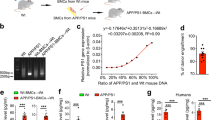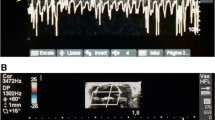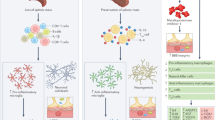Abstract
Inactivation of the adenosine A2A receptor (A2AR) consistently protects against ischemic brain injury and other neural insults, but the relative contribution of A2ARs on peripheral inflammatory cells versus A2ARs expressed on neurons and glia is unknown. We created a chimeric mouse model in which A2ARs on bone marrow–derived cells (BMDCs) were selectively inactivated or reconstituted by bone marrow transplantation. Selective reconstitution of A2ARs on BMDCs (A2AR knockout mice transplanted with wild-type bone marrow cells) largely reinstates ischemic brain injury in global A2AR knockout mice. Conversely, selective inactivation of A2ARs on BMDCs (wild-type mice transplanted with A2AR knockout bone marrow cells) attenuates infarct volumes and ischemia-induced expression of several proinflammatory cytokines in the brain, but exacerbates ischemic liver injury. These results indicate that the A2AR-stimulated cascade in BMDCs is an important modulator of ischemic brain injury and that ischemic brain and liver injuries are regulated distinctly by A2ARs on BMDCs.
This is a preview of subscription content, access via your institution
Access options
Subscribe to this journal
Receive 12 print issues and online access
$209.00 per year
only $17.42 per issue
Buy this article
- Purchase on Springer Link
- Instant access to full article PDF
Prices may be subject to local taxes which are calculated during checkout






Similar content being viewed by others
References
Chen, J.F. The adenosine A(2A) receptor as an attractive target for Parkinson's disease treatment. Drug News Perspect. 16, 597–604 (2003).
Fredholm, B.B. Adenosine receptors as targets for drug development. Drug News Perspect. 16, 283–289 (2003).
Ribeiro, J.A., Sebastiao, A.M. & de Mendonca, A. Adenosine receptors in the nervous system: pathophysiological implications. Prog. Neurobiol. 68, 377–392 (2002).
Schwarzschild, M.A., Chen, J.F. & Ascherio, A. Caffeinated clues and the promise of adenosine A(2A) antagonists in PD. Neurology 58, 1154–1160 (2002).
Dunwiddie, T.V. & Masino, S.A. The role and regulation of adenosine in the central nervous system. Annu. Rev. Neurosci. 24, 31–55 (2001).
Latini, S. & Pedata, F. Adenosine in the central nervous system: release mechanisms and extracellular concentrations. J. Neurochem. 79, 463–484 (2001).
Rudolphi, K.A., Schubert, P., Parkinson, F.E. & Fredholm, B.B. Neuroprotective role of adenosine in cerebral ischaemia. Trends Pharmacol. Sci. 13, 439–445 (1992).
Johansson, B. et al. Hyperalgesia, anxiety, and decreased hypoxic neuroprotection in mice lacking the adenosine A1 receptor. Proc. Natl. Acad. Sci. USA 98, 9407–9412 (2001).
Von Lubitz, D.K., Paul, I.A., Ji, X.D., Carter, M. & Jacobson, K.A. Chronic adenosine A1 receptor agonist and antagonist: effect on receptor density and N-methyl-D-aspartate induced seizures in mice. Eur. J. Pharmacol. 253, 95–99 (1994).
Chen, J.F. et al. A(2A) adenosine receptor deficiency attenuates brain injury induced by transient focal ischemia in mice. J. Neurosci. 19, 9192–9200 (1999).
Chen, J.F. et al. Neuroprotection by caffeine and A(2A) adenosine receptor inactivation in a model of Parkinson's disease. J. Neurosci. 21, RC143 (2001).
Blum, D. et al. A dual role of adenosine A2A receptors in 3-nitropropionic acid-induced striatal lesions: implications for the neuroprotective potential of A2A antagonists. J. Neurosci. 23, 5361–5369 (2003).
Popoli, P. et al. Blockade of striatal adenosine A2A receptor reduces, through a presynaptic mechanism, quinolinic acid-induced excitotoxicity: possible relevance to neuroprotective interventions in neurodegenerative diseases of the striatum. J. Neurosci. 22, 1967–1975 (2002).
de Mendonca, A., Sebastiao, A.M. & Ribeiro, J.A. Adenosine: does it have a neuroprotective role after all? Brain Res. Brain Res. Rev. 33, 258–274 (2000).
Jones, P.A., Smith, R.A. & Stone, T.W. Protection against kainate-induced excitotoxicity by adenosine A2A receptor agonists and antagonists. Neuroscience 85, 229–237 (1998).
Jones, P.A., Smith, R.A. & Stone, T.W. Protection against hippocampal kainate excitotoxicity by intracerebral administration of an adenosine A2A receptor antagonist. Brain Res. 800, 328–335 (1998).
Phillis, J.W. The effects of selective A1 and A2a adenosine receptor antagonists on cerebral ischemic injury in the gerbil. Brain Res. 705, 79–84 (1995).
Monopoli, A., Lozza, G., Forlani, A., Mattavelli, A. & Ongini, E. Blockade of adenosine A2A receptors by SCH 58261 results in neuroprotective effects in cerebral ischaemia in rats. Neuroreport 9, 3955–3959 (1998).
Ikeda, K., Kurokawa, M., Aoyama, S. & Kuwana, Y. Neuroprotection by adenosine A2A receptor blockade in experimental models of Parkinson's disease. J. Neurochem. 80, 262–270 (2002).
Fink, J.S. et al. Genetic and pharmacological inactivation of the adenosine A2A receptor attenuates 3-nitropropionic acid-induced striatal damage. J. Neurochem. 88, 538–544 (2004).
Dall'lgna, O.P., Porciuncula, L.O., Souza, D.O., Cunha, R.A. & Lara, D.R. Neuroprotection by caffeine and adenosine A(2A) receptor blockade of beta-amyloid neurotoxicity. Br. J. Pharmacol. 138, 1207–1209 (2003).
Marchi, M. et al. Effects of adenosine A1 and A2A receptor activation on the evoked release of glutamate from rat cerebrocortical synaptosomes. Br. J. Pharmacol. 136, 434–440 (2002).
Marcoli, M. et al. Sensitivity to selective adenosine A1 and A2A receptor antagonists of the release of glutamate induced by ischemia in rat cerebrocortical slices. Neuropharmacology 45, 201–210 (2003).
O'Regan, M.H., Simpson, R.E., Perkins, L.M. & Phillis, J.W. The selective A2 adenosine receptor agonist CGS 21680 enhances excitatory transmitter amino acid release from the ischemic rat cerebral cortex. Neurosci. Lett. 138, 169–172. (1992).
Schwarzschild, M.A. et al. Neuroprotection by caffeine and more specific A2A receptor antagonists in animal models of Parkinson's disease. Neurology 61, S55–S61 (2003).
Cassada, D.C. et al. Adenosine A2A agonist reduces paralysis after spinal cord ischemia: correlation with A2A receptor expression on motor neurons. Ann. Thorac. Surg. 74, 846–849; discussion 849–850 (2002).
Cassada, D.C. et al. Adenosine A2A analogue improves neurologic outcome after spinal cord trauma in the rabbit. J. Trauma 53, 225–229; discussion 229–231 (2002).
Mayne, M. et al. Adenosine A2A receptor activation reduces proinflammatory events and decreases cell death following intracerebral hemorrhage. Ann. Neurol. 49, 727–735 (2001).
Day, Y.J. et al. Renal protection from ischemia mediated by A2A adenosine receptors on bone marrow-derived cells. J. Clin. Invest. 112, 883–891 (2003).
Day, Y.J. et al. Protection from ischemic liver injury by activation of A2A adenosine receptors during reperfusion: inhibition of chemokine induction. Am. J. Physiol. Gastrointest. Liver Physiol. 286, G285–G293 (2004).
Linden, J. Molecular approach to adenosine receptors: receptor-mediated mechanisms of tissue protection. Annu. Rev. Pharmacol. Toxicol. 41, 775–787 (2001).
Ohta, A. & Sitkovsky, M. Role of G-protein-coupled adenosine receptors in downregulation of inflammation and protection from tissue damage. Nature 414, 916–920 (2001).
Fiser, S.M. et al. Adenosine A2A receptor activation decreases reperfusion injury associated with high-flow reperfusion. J. Thorac. Cardiovasc. Surg. 124, 973–978 (2002).
Fredholm, B.B., Cunha, R.A. & Svenningsson, P. Pharmacology of adenosine A2A receptors and therapeutic applications. Curr. Top. Med. Chem. 3, 413–426 (2003).
Aden, U. et al. Aggravated brain damage after hypoxic ischemia in immature adenosine A2A knockout mice. Stroke 34, 739–744 (2003).
Fredholm, B.B., Cunha, R.A. & Svenningsson, P. Pharmacology of Adenosine A(2A) Receptors and Therapeutic Applications. Curr. Top. Med. Chem. 3, 413–426 (2003).
Orkin, S.H. & Zon, L.I. Hematopoiesis and stem cells: plasticity versus developmental heterogeneity. Nat. Immunol. 3, 323–328 (2002).
Sitkovsky, M.V. et al. Physiological control of immune response and inflammatory tissue damage by hypoxia-inducible factors and adenosine A2A receptors. Annu. Rev. Immunol. 22, 657–682 (2004).
Cronstein, B.N. Adenosine, an endogenous anti-inflammatory agent. J. Appl. Physiol. 76, 5–13 (1994).
Teng, M.K. et al. Identification of a common docking topology with substational variation among different TCR-peptide-MHC complexes. Curr. Biol. 8, 409–412 (1998).
Loddick, S.A., Turnbull, A.V. & Rothwell, N.J. Cerebral interleukin-6 is neuroprotective during permanent focal cerebral ischemia in the rat. J. Cereb. Blood Flow Metab. 18, 176–179 (1998).
Clark, W.M., Rinker, L.G., Lessov, N.S., Hazel, K. & Eckenstein, F. Time course of IL-6 expression in experimental CNS ischemia. Neurol. Res. 21, 287–292 (1999).
Smith, C.J. et al. Peak plasma interleukin-6 and other peripheral markers of inflammation in the first week of ischaemic stroke correlate with brain infarct volume, stroke severity and long-term outcome. BMC Neurol. 4, 2 (2004).
Castillo, J. et al. The release of tumor necrosis factor-alpha is associated with ischemic tolerance in human stroke. Ann. Neurol. 54, 811–819 (2003).
Acalovschi, D. et al. Multiple levels of regulation of the interleukin-6 system in stroke. Stroke 34, 1864–1869 (2003).
Altare, F. et al. Impairment of mycobacterial immunity in human interleukin-12 receptor deficiency. Science 280, 1432–1435 (1998).
Mroz, K., Carrel, L. & Hunt, P.A. Germ cell development in the XXY mouse: evidence that X chromosome reactivation is independent of sexual differentiation. Dev. Biol. 207, 229–238 (1999).
Rosin, D.L., Robeva, A., Woodard, R.L., Guyenet, P.G. & Linden, J. Immunohistochemical localization of adenosine A2A receptors in the rat central nervous system. J. Comp. Neurol. 401, 163–186. (1998).
Huang, Z. et al. Effects of cerebral ischemia in mice deficient in neuronal nitric oxide synthase. Science 265, 1883–1885 (1994).
Acknowledgements
We thank B.B. Fredholm and M.A. Schwarzschild for discussion and critical reading of the manuscript and D. Xu for assistance with FACS analysis. This work was supported in part by grants NS37403, NS41083 (J-F.C.) and NS-10828 (M.M.) from the US National Institutes of Health and by Bumpus Foundation (J-F.C.).
Author information
Authors and Affiliations
Corresponding author
Ethics declarations
Competing interests
The authors declare no competing financial interests.
Supplementary information
Supplementary Table 1
Cerebrovascular and systemic physiology before, during and after MCAO-induced ischemia in WT→WT and KO→WT mice (PDF 19 kb)
Supplementary Table 2
Primers sequences for the genotyping and qPCR analysis (PDF 21 kb)
Rights and permissions
About this article
Cite this article
Yu, L., Huang, Z., Mariani, J. et al. Selective inactivation or reconstitution of adenosine A2A receptors in bone marrow cells reveals their significant contribution to the development of ischemic brain injury. Nat Med 10, 1081–1087 (2004). https://doi.org/10.1038/nm1103
Received:
Accepted:
Published:
Issue Date:
DOI: https://doi.org/10.1038/nm1103
This article is cited by
-
Perivascular AQP4 dysregulation in the hippocampal CA1 area after traumatic brain injury is alleviated by adenosine A2A receptor inactivation
Scientific Reports (2017)
-
Adenosine A2A receptor inactivation alleviates early-onset cognitive dysfunction after traumatic brain injury involving an inhibition of tau hyperphosphorylation
Translational Psychiatry (2017)
-
Dual roles of the adenosine A2a receptor in autoimmune neuroinflammation
Journal of Neuroinflammation (2016)
-
Continuous adenosine A2A receptor antagonism after focal cerebral ischemia in spontaneously hypertensive rats
Naunyn-Schmiedeberg's Archives of Pharmacology (2014)
-
Activation of microglial cells triggers a release of brain-derived neurotrophic factor (BDNF) inducing their proliferation in an adenosine A2A receptor-dependent manner: A2A receptor blockade prevents BDNF release and proliferation of microglia
Journal of Neuroinflammation (2013)



